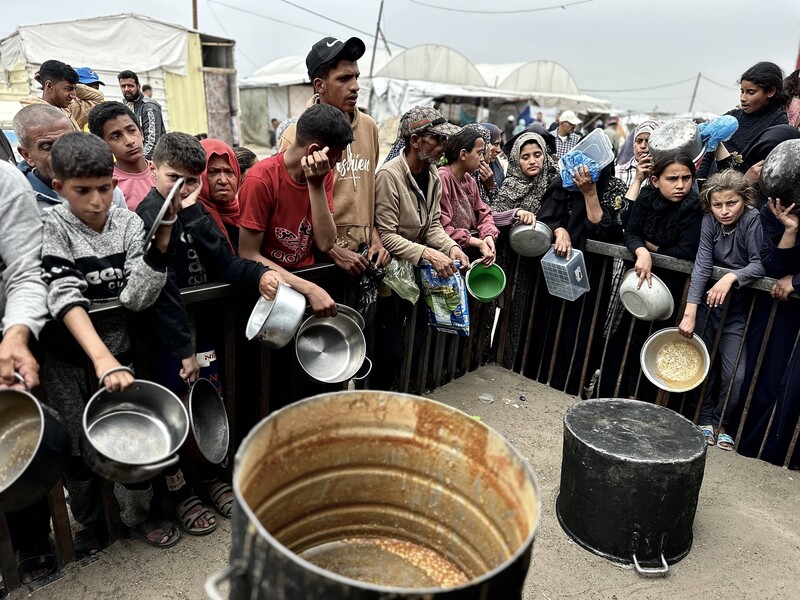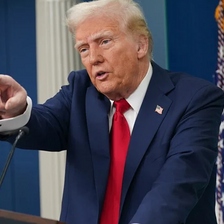The Electronic Intifada 17 April 2025

Palestinians gather for food distribution in Khan Younis on 2 April.
APA imagesIsrael resumed its genocidal attacks on the Gaza Strip on 18 March, issuing evacuation orders for nearly 37 percent of the territory and designating these areas as combat zones.
This escalation followed Israel’s complete closure of the Rafah crossing in early March, cutting off essential supplies – food, medicine and fuel – pushing Gaza’s already dire humanitarian crisis to the edge of catastrophe. By late March, the situation had worsened, with Israel ordering the full evacuation of Palestinians from Rafah, a city devastated by invasion since May 2024, albeit briefly interrupted by a ceasefire.
According to Axios, citing a senior Israeli official’s comments to the media, the Israeli military has intensified its ground offensive, aiming to occupy 25 percent of Gaza within weeks as part of a “maximum pressure” campaign to force Hamas to release hostages. Thousands who already lost their homes may never return, as entire neighborhoods reduced to rubble in previous attacks are now being overtaken by Israeli forces.
Gaza is shrinking, fueling fears that this is the first step in a larger plan to displace Palestinians entirely. Israeli officials have openly discussed plans for long-term control over occupied areas, with some calling for the forced transfer of Palestinians to neighboring countries. With no safe zones and sealed borders, we are trapped – pushed from place to place, starving under relentless bombardment, while essential infrastructure, including hospitals and shelters, collapses under the weight of destruction.
These attacks came after Israel broke a fragile two-month ceasefire, during which speeches and plans were made about Gaza’s possible future.
The battle over Gaza’s future
Gaza’s destruction is not just physical; it represents a calculated political and cultural erasure. Israel’s military operations have systematically targeted historic landmarks, institutions and refugee camps, dismantling Gaza’s historical and cultural identity. As discussions about the future, which seems distant, take center stage, the real question is not only about rebuilding but about who will shape Gaza’s future – and for what purpose.
US President Donald Trump proposed a dangerous plan to displace Gaza’s population, take ownership of the land and transform it into a tourist destination – the “Riviera of the Middle East” – prioritizing economic projects over Palestinian existence.
Yet Trump’s vision is not the only one shaping Gaza’s fate. The Arab Summit, led by Egypt in early March, endorsed a three-phase reconstruction plan for Gaza. This plan includes clearing unexploded ordnance, removing rubble and establishing temporary housing for displaced Palestinians. It emphasizes Palestinian leadership, rejects forced displacement and calls for unity under the Palestine Liberation Organization with international support, including the possible deployment of UN peacekeepers.
However, the true question remains: How much control will Palestinians have?
Although the Arab plan presents us as decision makers, the framework still allows regional and international powers to dictate outcomes. It excludes Hamas from the governance structures. Meanwhile, the Palestinian Authority’s ability to govern effectively is in doubt, given its weakness and heavy reliance on external support that often comes with strict conditions and political concessions.
The plan assumes that the peace agreements, the establishment of a Palestinian state, the end of the Israeli occupation that began in 1967 and Israel’s complete withdrawal from all Palestinian lands would mark the end of Palestinian resistance activities and all related Palestinian and Israeli claims. This would initiate a transitional period for normalizing relations, to be agreed upon in detail between the two sides.
But is this outcome realistic?
It depends on Israel’s willingness to withdraw and recognize Palestinian sovereignty.
If Israel refuses, as is often the case, will Palestinian factions disarm or will resistance continue?
A new form of erasure
Israel’s war on Gaza has not ceased militarily, and it continues through political negotiations aimed at achieving the same goals. The destruction of Gaza’s buildings, refugee camps and historical landmarks is not accidental. It is part of a broader strategy to transform Gaza into a place that cannot resist or remember. From missiles to urban planning, the aim remains unchanged: Erase the roots of resistance, rewrite the narrative and create a history that serves the occupier.
The so-called crossings on the Arab plan’s map create the illusion of access while Israel tightens its control over Gaza, enforcing a harsh siege. The map also divides the Gaza Strip into five sections, each with a distinct focus: Rafah as the logistical hub, Khan Younis as the center for science and knowledge, Deir al-Balah as the city of peace, Gaza City as the political center, and north Gaza as the cultural hub. These divisions, while seemingly well-organized, fail to address Gaza’s underlying political realities. Gaza’s population continues to live under Israeli control, and these divisions do nothing to resolve the larger political issues.
In the plan, a phrase is mentioned: “the new Gaza, the right to peace.” While it may sound like a hopeful call for the future, it raises crucial questions:
What does “the new Gaza” truly mean?
Whose right to peace is being prioritized?
Because the kind of peace we have come to know from the United States and Israel is one where we are confined to cages and cantons – trapped while Israelis kill us and call us the murderers. Repeating such statements creates something of an illusion because without a genuine shift in policy and action, these words remain hollow.
In addition, residential buildings are concentrated to the west, facing the sea – an area that Israel once deemed a humanitarian zone. The border areas are designated as agricultural zones, largely devoid of residential buildings following demolition by the Israeli military. This leads to the Israeli demand for creating buffer zones, supporting Israel’s goal of isolating Gaza’s population and displacing it to outside the coastal territory. What is happening on the ground reflects this intent.
But why buffer zones?
Israel claims they are for security. In reality, however, they push Palestinians farther from their land. Israeli citizens will not see Palestinians from their windows, but Palestinians will be forced to look at their own lands, including agricultural areas, that they cannot access and control.
Will families once living in these areas be pushed into high-rise buildings, confined to smaller, controlled spaces?
If so, this is not reconstruction – it’s confinement.
The United States and Israel have rejected the Arab reconstruction plan. This raises questions:
How much influence can Arab countries have when their views go against US and Israeli interests?
Where does this leave us – the people of Gaza?
Why isn’t the voice of our leaders enough?
Is there any Palestinian leader we can trust?
Despite public endorsements, the Arab League’s reconstruction plan remains just that – a plan. No concrete steps have been taken to implement it, leaving the Arab world’s response confined to rhetoric and written proposals, even after the war resumed.
Israel is rapidly changing Gaza’s reality, occupying and reconfiguring it as it sees fit – indifferent to words and condemnations.
Ongoing effort to sideline Palestinians
In Gaza Diaries, Muin Bseiso, one of the most prominent poets of the Palestinian resistance, recounts a little-known chapter of Gaza’s history – the Israeli demolition of a statue for the Unknown Soldier following the Israeli occupation in 1967. Erected in 1956 under Egyptian administration, the soldier’s statue stood as a tribute to Egyptian and Palestinian soldiers who had fought against Israeli occupation. The towering statue of a soldier, weapon in hand, symbolized defiance and resistance.
Yet, when Israeli forces occupied Gaza in 1967, they destroyed the monument’s pedestal. The next morning, the Israeli governor arrived to inspect the site, only to find it covered in flowers, as though nothing had happened. In a quiet act of defiance, the people of Gaza had gathered the fragments of the monument and hidden them in their homes. The Israeli military, disturbed by this, conducted an unusual search – not for weapons, but for the missing pieces of stone.
Bseiso suggests that the governor’s frustration reflected a deeper colonial impulse: to erase not just the physical monuments, but the spirit of the people. He echoes an old doctrine of conquest: “If you want to kill a people, you must first kill the symbols they love. Erase everything that ties them spiritually to their struggle. Kill their history, their memory, their icons … and then, only then, go after them.”
The real fear wasn’t the rebuilding of the monument, but the resurrection of its significance in Palestinian consciousness. If even one stone remained, it could serve as a foundation for something greater – not in physical form, but in meaning. For the first time, an army found itself at war with fragments of stone. The soldiers weren’t searching for fighters; they were searching for memory itself. In Gaza, remembering is a way of rebuilding what was destroyed.
Despite its destruction, the site of the Unknown Soldier remains embedded in Gaza’s historical consciousness. To this day, the area where the monument once stood is called the Unknown Soldier Square. When Palestinian sovereignty was partially restored under the PA, the monument was rebuilt, only to be struck by an Israeli missile in 2005. In 2023, during Israel’s latest invasion, the entire area was destroyed once again.
The people of Gaza, whose voices are often silenced regarding their future, are left with little more than fragments of history. Just as they once gathered the fragments of a monument to defy those who sought to crush their spirit, they will continue to cling to their memories, stories and land. They will resist and rebuild – not just their homes, but their very identity. Yet the power wielded against them is immense and harsh, and with each wave of complicity and silence, it grows harder to find a flicker of hope.
Gaza is an ancient land with over 5,000 years of history, shaped by civilizations from the Canaanites and Philistines to the Ottomans. Through countless wars, it has endured and rebuilt itself time and again. Its resistance is etched into its stones, streets and people. More than a place, Gaza is a symbol of an enduring struggle – one that we fear might soon be erased from both memory and history. Gaza is the known soldier. But even the soldier, it seems, is becoming invisible.
Malak Hijazi is a Gaza-based writer.





